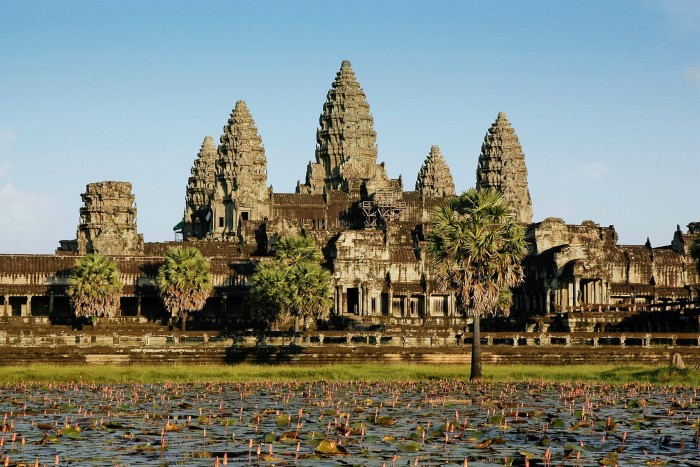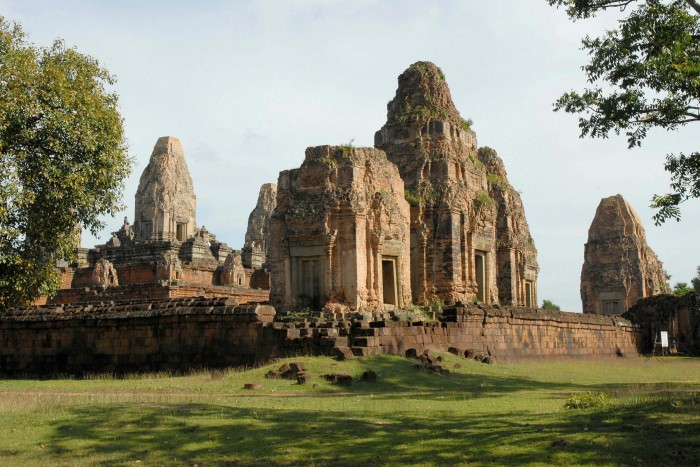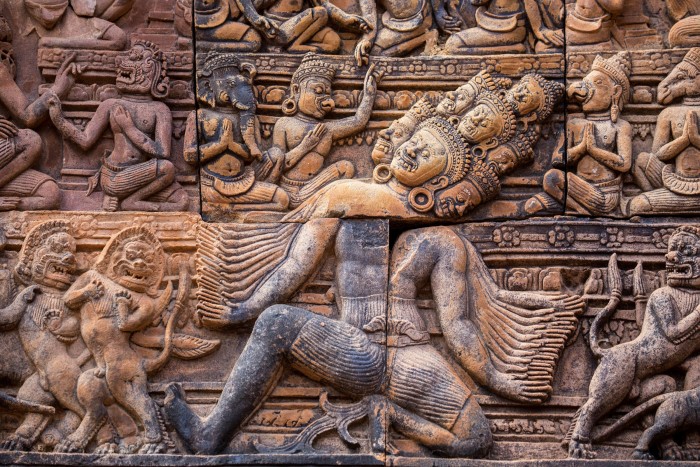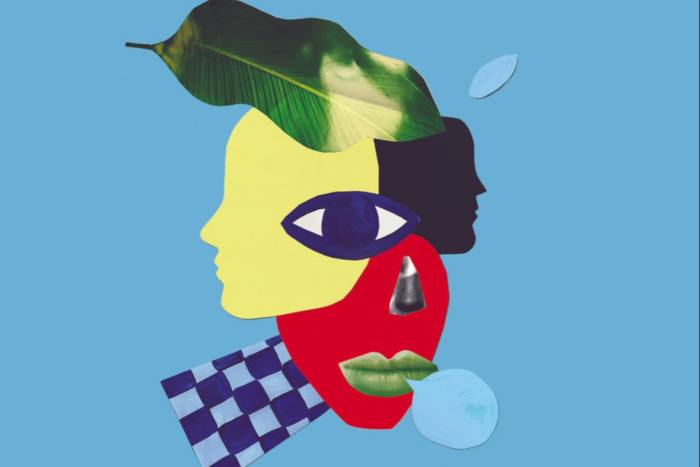In the far north-west of Cambodia, beyond the waters of the Great Lake, a line of blue mountains rises from the rich plains of ripe paddy fields that stretch up from the Mekong delta. At first, these hills climb sharply from the lush flatland; then, quite suddenly, they crest into a long, straight sandstone plateau that seems to float mysteriously above the low clouds.
These are the heights of Phnom Kulen, the “Mountain of Lychees”. For Cambodians, this is a sacred space: the birthplace not just of the great Angkorian Empire but also of the holy rivers that watered its plains and lapped around its most precious temples.
Here, in 802, the Khmer prince Jayavarman II performed a ceremony initiating what would soon become the richest and most powerful state of its time. He had spent his teens as a hostage of the Buddhist rulers of Java, where he may have seen the building of the great pyramid-temple of Borobudur, still the largest Buddhist monument in the world. But Prince Jayavarman was a passionate Hindu who looked to Lord Shiva as his God. He escaped from Java aged around 20, and in the 790s returned to Cambodia, declaring himself independent from foreign overlords.
One of his first actions was to found a new city, Mahendraparvata, on the summit of Phnom Kulen, its name derived from the legendary Hindu peak of Mount Mahendra, the “Monarch among Mountains”. The great ritual that took place there in 802 had both theological and political significance: not only did it make it “impossible for Java to control holy Cambodia”, as an ancient inscription puts it, it also consecrated Jayavarman as King of All, and Lord Shiva’s representative on earth. This was marked by the installation of a sacred state symbol, known as the devaraja lingam, which Jayavarman dedicated to Shiva, Lord of the Mountains.

Jayavarman went on to fight a series of battles and to forge a matrix of alliances that would unite disparate regions of south-east Asia into the state henceforth called Kambujadesa or Cambodia. An inscription survives that gives the borders of Jayavarman II’s kingdom as “China, Champa [Vietnam], the ocean, and the land of cardamoms and mangoes” [Thailand]” .
At its peak in the 12th and 13th centuries, the urbanised region centred on Angkor, the Khmer capital, had a population of at least 900,000 people — far more than the 20,000-30,000 then dwelling in London. The area within the moat of just one Khmer temple, Angkor Wat, is on its own almost four times the size of Vatican City. Yet the place of this great state’s founding is now all but lost in the jungle.
Out of the massive sandstone outcrop of Phnom Kulen, near a place called Kbal Spean, rises one of the headwaters of the Siem Reap river, which in turn flows on to Angkor Wat. Compared in Khmer inscriptions to the Ganges itself, these waters remain sacred to Cambodians, though the country is predominantly Buddhist now.
One morning, while walking by Kbal Spean, I fell in with a lean, barefoot, shaven-headed monk in orange-brown robes. When I first saw him, he appeared to be asleep on a hammock strung between two teak trees — but hearing me pass, he smiled and swung out of the hammock to greet me. He then pointed into the river.

At first I didn’t understand what he was pointing to. Fish? Weeds? Pebbles? In fact it was none of these. On the bed of the stream, at first partially obscured by the rushing current, lay the unmistakable shape of a stone face. As my eyes adjusted, and focused through the running waters, I realised that the face was attached to a body, and to several arms, each holding a weapon or a noose. Above the face was a tall, domed headdress, forming a Khmer crown.
What the monk was pointing out was in fact the form of Shiva sculpted on the rock of the river-bed. Around and about it were hundreds of yoni-lingam, sacred Hindu symbols, arranged in squares and filling the entire space from bank to bank.
The extraordinary sculptures were a legacy of Cambodia’s conversion to Hinduism, a process that had been under way since the fifth century but accelerated alongside Jayavarman’s conquests. A group of ascetic followers of Shiva, known as the Pasupatas, arrived in Cambodia from India, spearheading a wave of Shiva worship, which for a time became the dominant faith in the region.

The Pasupatas were wandering Brahmins — or priests — who smeared their bodies with ash from cremation grounds and slept on a bed of ashes. Through their austere, self-denying practices, they believed they could cross over to the world beyond, achieving union with the divine.
But they also acquired power in this world too. Indian Brahmins had for centuries been willing to assist kings with rituals and astrological prophecies, as well as with more mundane skills such as literacy and numeracy. The Pasupatas offered more: secret spiritual knowledge and yogic powers, such as the ability to fly or to hear distant conversations, and mantras that could enable a king to prevail over his enemies.
In Jayavarman’s service, the Pasupatas performed rituals and oversaw the carving of sculptures that they believed would extend the Hindu holy land from India to Cambodia. The landscape was permeated with divinity, with temple reservoirs consecrated in Shiva’s name, lingams matching those in India, and, above all, temple pyramids modelled on his mountain home.
The first of these, the ziggurat-like sanctuary built by Jayavarman for the consecration of the devaraja lingam, was erected on Phnom Kulen. But despite its significance in Cambodia’s history, it has been largely forgotten today, and lies far off the beaten track in a jungle where Khmer Rouge landmines are still a hazard.
There is not even a road: to get there, I had to hitch a lift on the back of a motorbike driven by one of the monk’s friends, who bumped his way along a dry water course, edged by cashew orchards and pepper vines. Eventually, 10 miles from the nearest tarmac road, we found the great step pyramid. In the middle of the topmost layer, abandoned in the scrub-jungle, stood the plinth on top of which the original devaraja lingam had once rested, all that remained of the temple where the Angkorian Empire was founded.
Towards the end of his reign, Jayavarman went on to build a second Khmer capital on the plains of Angkor at Hariharalaya near modern-day Siem Reap, on the edge of the Great Lake. It was here he built the first of the network of dams and reservoirs that would allow the Khmers to become one of the great hydraulic civilisations of history, able to cultivate the quantities of rice that its burgeoning urban population needed. It is also the best base today for exploring the great legacies of that civilisation.
When I first saw it, however, back in the 1980s, not long after the end of Khmer Rouge rule, it was a tatty ex-French colonial town, looking back to the days before the Maoist armies emptied the cities and created the infamous Killing Fields. I visited with my young family and stayed in the king of Cambodia’s old guest house, which had just been converted into the stylish Amansara Hotel. Things got off to a good start when the hotel sent King Sihanouk’s old pre-war Mercedes limousine to meet us at Siem Reap airfield.



So gentle and peaceful were the Cambodians we met — the smiling schoolchildren, the farmers in paddy hats, the village women on their way to market — that my children refused to believe the stories I tried to tell them of the days of the Khmer Rouge. Only when we visited the Siem Reap crocodile farm did they really begin to think about the horrors that the country had undergone. The regime had apparently used it as an execution ground; when my children crossed the bridge over the pens from which (it was said) captives had been thrown to the crocodiles, they were greeted by a ricochet of hopeful snapping jaws.
Today Siem Reap has been transformed. The airfield is now an international airport, and while the Amansara is still much the most luxurious hotel in town, hundreds of bars, restaurants and hotels of all sizes have opened up.
During the coronavirus pandemic, the authorities took advantage of the respite to improve the town’s roads, and to replant the shady trees cut down when the Khmer Rouge were in charge. It now looks as gorgeous as it ever did during the most elegant phase of colonial rule, but with many more places to stay, eat and drink.
The exquisite temple of Banteay Srei, just outside Siem Reap, is probably my favourite in the country — without question one of the loveliest temples in south-east Asia. Commissioned in the 10th century by Yajnavaraha, an adviser to the Khmer king, and one of his fellow courtiers, it is dedicated to Shiva and swarms with magnificent stone carvings: of Durga, the mother goddess, dancing her way to victory over the buffalo god; of Pasupata ascetics with piled-up dreadlocks and rudraksha prayer beads; of Kamadeva, the god of love, firing an arrow at Lord Shiva.

Yajnavaraha, who was a Sanskrit scholar, seems to have planned the temple almost as a demonstration of his wide reading, with two gorgeous pavilion-libraries and carved panels showing familiarity with the work of the great Indian playwright Kalidasa. More surprising still is a panel depicting the wonderful Tamil poet Karaikkal Ammaiyar, who is said to have renounced her great beauty as an act of devotion to Shiva, preferring to venerate him as an emaciated ascetic; she was rewarded with literary gifts that turned her into one of the greatest of all Tamil poets.
While much loved in Tamil lands, in India’s far south, Karaikkal Ammaiyar does not seem to be well known even in neighbouring Andhra Pradesh; and yet here she is, sculpted in stone, sitting at Shiva’s dancing feet in distant Cambodia.
Far from being on the periphery of the Indic literary world, Cambodia was a sophisticated centre of poetry, drama, epigraphy and civilisation — and never more so than when its Khmer rulers built the largest and most magnificent Hindu temple in the world, at Angkor Wat.
Construction of this vast 160-hectare complex began in 1122, during the reign of the greatest of all south-east Asian rulers, Suryavarman II, who had fought his way to the throne in 1113. Though the central statue of Vishnu — a break with Suryavarman’s Shiva-favouring predecessors — was dedicated during his lifetime, building was still going on at the time of his death in 1150.



The moat alone took 5,000 men 10 years of digging, while the temple inside it contains more stone than the largest Egyptian pyramid. No mortar was used — the stones were fitted together with joints and tenons rather than cement — and almost every inch was intricately carved, in situ, by stonemasons of great skill and imagination. Yet this stupendous project was completed in just 32 years, a fraction of the time it took to build the much smaller cathedrals of medieval Europe.
There was nothing of this scale at the time, even in India, the centre of the Hindu world to which the Khmers looked for literary and religious inspiration. Angkor Wat is roughly contemporary with the great south Indian Chola temples of Thanjavur, and the Khmers and Cholas — the two great powers on the Indian Ocean — were allies and in close dialogue. Nevertheless, although the largest Chola temples are five times the size of anything that preceded them, the Khmer temples do not just dwarf their Indian contemporaries many times over, but are the largest religious structure constructed anywhere in the ancient or medieval world.
Representing both a microcosm of the Hindu universe and a funerary monument for Suryavarman, it was built as a series of concentric courtyards surrounding a central pyramid. From this a quincunx of towers rises in a recreation of scriptural accounts of Mount Meru, the home of the Hindu gods.
As you approach it today, you see five mountains of masonry rising from the jungle in successive ranges — a great tumbling scree of plinths and capitals, fluted pillars and delicate lotus jambs. Shingled roofs cover intricate reliefs of semi-divine naga-snakes and holy men, of heavenly musicians and dancing girls, each individualised and many with the lively humanity of portraits. Inside, the west gallery is decorated with the most beautiful of all Khmer reliefs, illustrating the Indian epics, from the demon-king Ravana shaking Mount Kailash, Shiva’s dwelling place, in the Ramayana to the fateful battles of the Mahabharata.
The pandemic has had many adverse effects on travel, but for Angkor Wat it has had one significant upside: visitor numbers, which pre-pandemic were flooding the monument, are dramatically down. Now is an excellent moment to see one of the very greatest religious monuments in the world without having to compete with busloads of tourists trying to do likewise. My advice: don’t hesitate.
William Dalrymple’s ‘The Company Quartet’ is published by Bloomsbury
Details
William Dalrymple was a guest of Wild Frontiers (wildfrontierstravel.com), Singapore Airlines (singaporeair.com) and Amansara (aman.com). Wild Frontiers offers small group and private tours to Cambodia; its 14-day Cambodia Explorer tour, which covers many of the locations mentioned, costs from £2,845 full-board and including transport, guides and entrance fees, but not international flights. Singapore Airlines flies daily from Singapore to Siem Reap: returns from London via Singapore to Siem Reap cost from £705, though a £606 promotion is available until September 15. Amansara has double rooms from $1,400 per night half-board and including a guide for Angkor.
Find out about our latest stories first — follow @ftweekend on Twitter
FT Weekend Festival, London

Save the date for Saturday 3rd September to hear FT travel editor Tom Robbins and more than 100 authors, artists and experts at Kenwood House Gardens, London. Choose from 10 tents packed with ideas and an array of perspectives, featuring everything from debates to tastings, performances and more. Book your pass at ft.com/ftwf
Stay connected with us on social media platform for instant update click here to join our Twitter, & Facebook
We are now on Telegram. Click here to join our channel (@TechiUpdate) and stay updated with the latest Technology headlines.
For all the latest Business News Click Here
For the latest news and updates, follow us on Google News.
